Stanford faculty honor President John L. Hennessy with gifts and accolades
Members of the Stanford faculty and senior administration gathered on the Main Quadrangle to honor President John Hennessy. They also thanked Andrea Hennessy for her service to the university.
On a sunny afternoon in Stanford’s Main Quad on Wednesday, June 1, about 400 faculty and senior administrators gathered to honor John L. Hennessy, who is stepping down as president at the end of the summer.
In addition to celebrating Hennessy’s accomplishments over the past 16 years, they also thanked the president’s wife, Andrea Hennessy, for her service to the university.
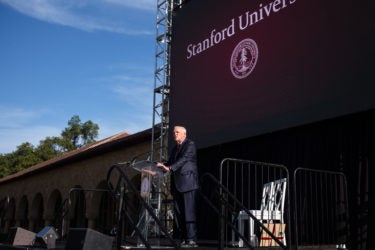
Image credit: Aaron Kehoe
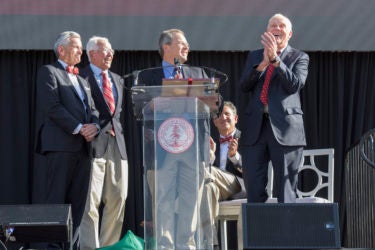
Image credit: L.A. Cicero
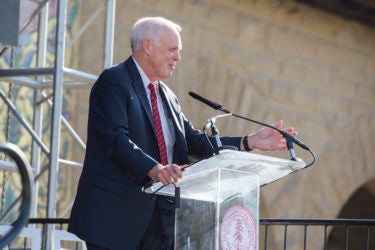
Image credit: L.A. Cicero
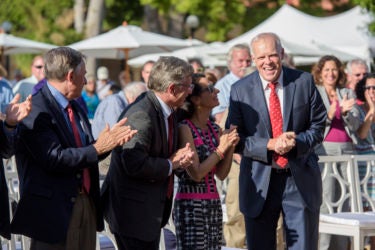
Image credit: L.A. Cicero
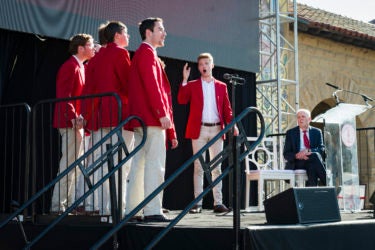
Image credit: L.A. Cicero

Image credit: Aaron Kehoe
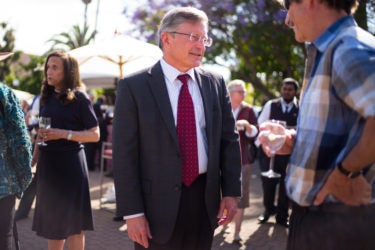
Image credit: Aaron Kehoe
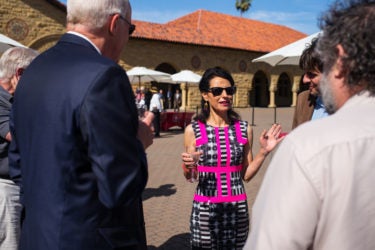
Image credit: Aaron Kehoe
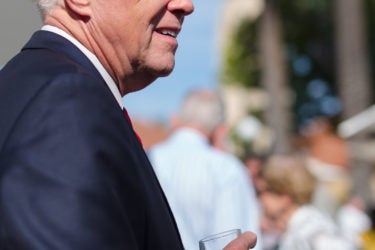
Image credit: Aaron Kehoe
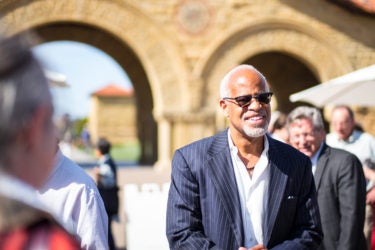
Image credit: Aaron Kehoe
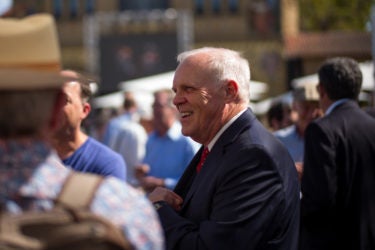
Image credit: Aaron Kehoe
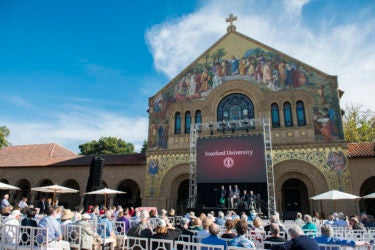
“Few people realize what an extraordinary commitment Andrea Hennessy has made to this university, not only in supporting John behind the scenes, but in being a gracious host at innumerable, uncountable functions, making every member of the Stanford family – donor, faculty, student, parent – feel welcome in her home,” said Provost John Etchemendy. “The university would not be what it is if John had not had you by his side.”
Etchemendy also said Andrea Hennessy’s impact on the arts at the university could not be overstated.
“Make no mistake, the entire arts district, from the Bing Concert Hall to the Anderson Collection to the McMurtry Building, is as much your legacy as it is John’s,” he said, addressing Andrea Hennessy, who was sitting in the front row of the audience. “We are so grateful for what you’ve done and all you’ve sacrificed to make Stanford a better place.”
Etchemendy then presented a gift to the couple: a sandstone bench created from the original capitals – hearts carved in stone – from the tops of the double sandstone columns that were replaced during the seismic strengthening of the campus arcades. Oleg Lobykin, the master sculptor who created the statues adorning Wallenberg Hall, created the bench.
“The bench is inscribed with a quote from John’s inauguration speech that summarizes well the last 16 years: ‘Our challenges are many, but our potential is unbounded,’” Etchemendy said. “On behalf of everyone at Stanford, I hope this bench will be an enduring symbol of our respect and affection for you both. I hope it will bring you many happy memories.”
In addition to Etchemendy, faculty and other colleagues lauded the president with witty, affectionate and poignant presentations on stage and in a video featuring senior university officials, students, deans, vice provosts, the chair of the Board of Trustees and former chairs. The Stanford Mendicants, a male a cappella group, sang the university hymn, “Hail, Stanford, Hail.”
Jim Plummer, a professor of electrical engineering and former dean of the School of Engineering, said the many new facilities in the Science and Engineering Quad, at the GSB, and in the arts district and elsewhere on campus have changed the campus landscape.
“But more importantly, they’ve changed Stanford,” he said. “The Bing Concert Hall and McMurty Building created spaces for the arts that did not exist at Stanford a decade ago. The buildings in the Science and Engineering Quad provide teaching and research space that have transformed how we teach and how we do research.”
He also praised Hennessy as a “relentless” champion of interdisciplinary teaching and research for solving big-problem and big-opportunity ideas.
Hennessy, who sat on the stage during the program, will become the inaugural director of the Knight-Hennessy Scholars program after stepping down as president. The program is a graduate-level scholarship to prepare a new generation of global leaders with the skills to address the increasingly complex challenges facing the world.
Jeff Wachtel, who has served as chief of staff to Hennessy throughout his presidential tenure and emceed Wednesday’s program, will be the Knight-Hennessy Scholars’ first executive director.
Kathryn Ann “Kam” Moler, chair of the Faculty Senate, and a professor of applied physics and of physics, recited quotes from former senate chairs, who described Hennessy as “solemn when necessary and joking when possible,” and as someone who models “respect for disagreement by disagreeing respectfully, but not imperiously, when he felt it was necessary.”
Moler, who served on the search committee for Hennessy’s successor, said the group learned that his leadership and accomplishments are heralded across the country.
“We heard over and over again that Stanford has become a national model for achieving the highest excellence in scholarship while addressing the world’s most pressing problems,” she said.
Turning to Hennessy, who was sitting on stage, Moler added: “We also heard over and over that you are one of the best, if not the best, university presidents of our age. I feel very lucky to have been here during this golden age for Stanford.”
Three of Hennessy’s golfing buddies took the stage together: Jeffrey Koseff, a professor of civil and environmental engineering and co-director of Stanford Woods Institute for the Environment; Charles G. Prober, a professor of pediatrics (infectious diseases) and of microbiology and immunology; and George Springer, a professor emeritus of aeronautics and astronautics. They praised Hennessy’s integrity, decency, friendship and unquenchable thirst for knowledge.
Koseff said Hennessy loves to tee off at – 6 a.m. – even in the dark, and as president could claim that tee time at Stanford Golf Course. To ensure that he would continue to enjoy golfing at first light, Koseff presented Hennessy with a framed certificate, signed by Bernard Muir, Stanford’s athletic director. Koseff read the inscription aloud:
“Let it be known that in recognition of the 16 years that he has brilliantly served Stanford as its 10th president and of the great passion and love he has for the game of golf, especially at the dawn of the day, the Stanford Golf Course bestows on John L. Hennessy the honor of first tee time for life.”
Hennessy thanked his colleagues for their gracious and generous words.
He said the decision to come to Stanford 39 years ago from the East Coast, where he and Andrea had deep roots and families, had changed their lives in dramatic ways.
Hennessy said it had been a real joy leading the university for the last 16 years, just as it was being a member of the faculty. Hennessy, who joined Stanford’s faculty in 1977, is a professor of electrical engineering and of computer science.
“It has filled my mind and my intellectual curiosity and thirst,” he said.
“I’m not leaving,” Hennessy continued. “I’m going back to the job I came here to do at the beginning, to work with our students and our faculty colleagues, which I think is the highest possible calling we could ever have.”
